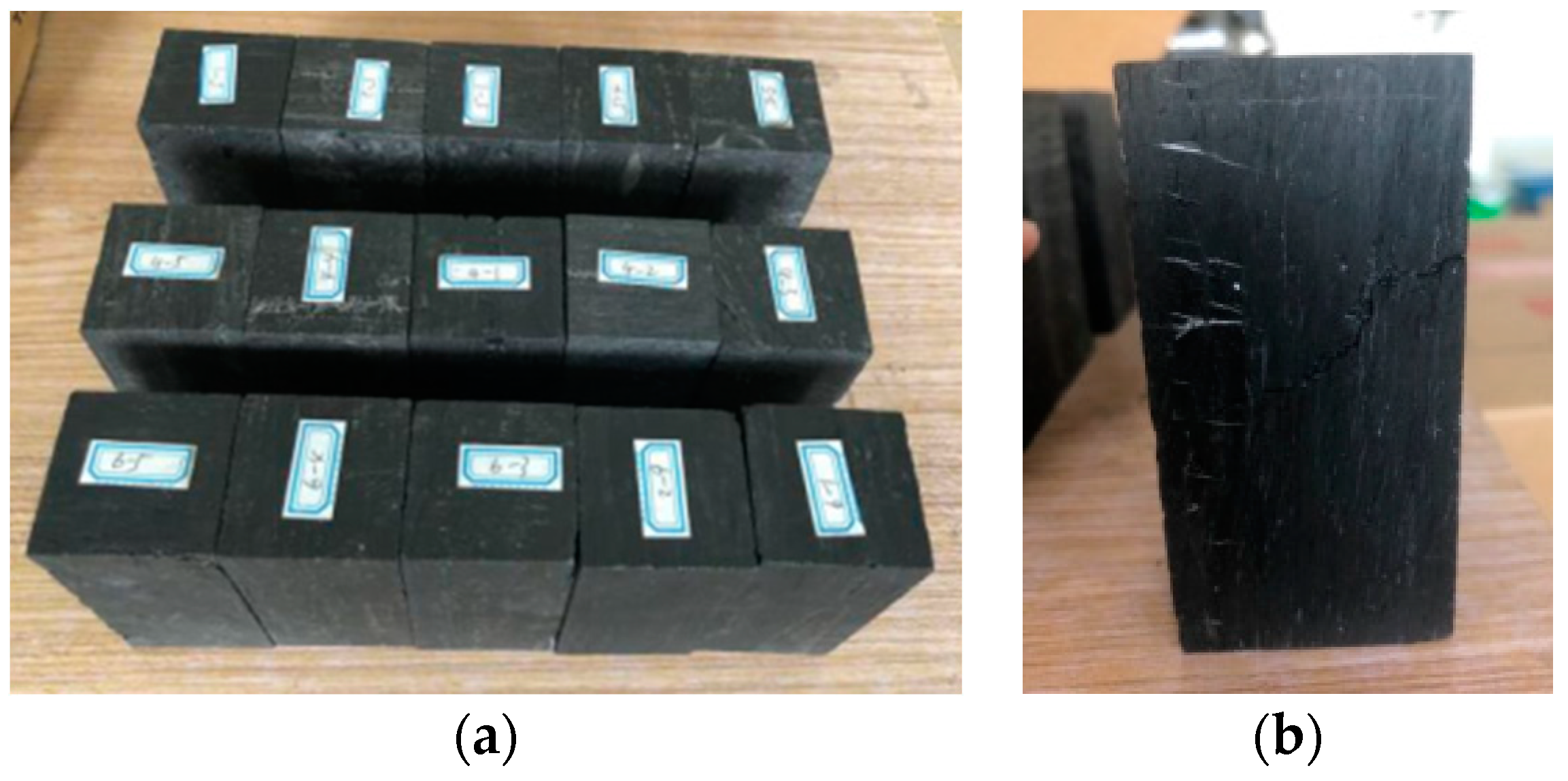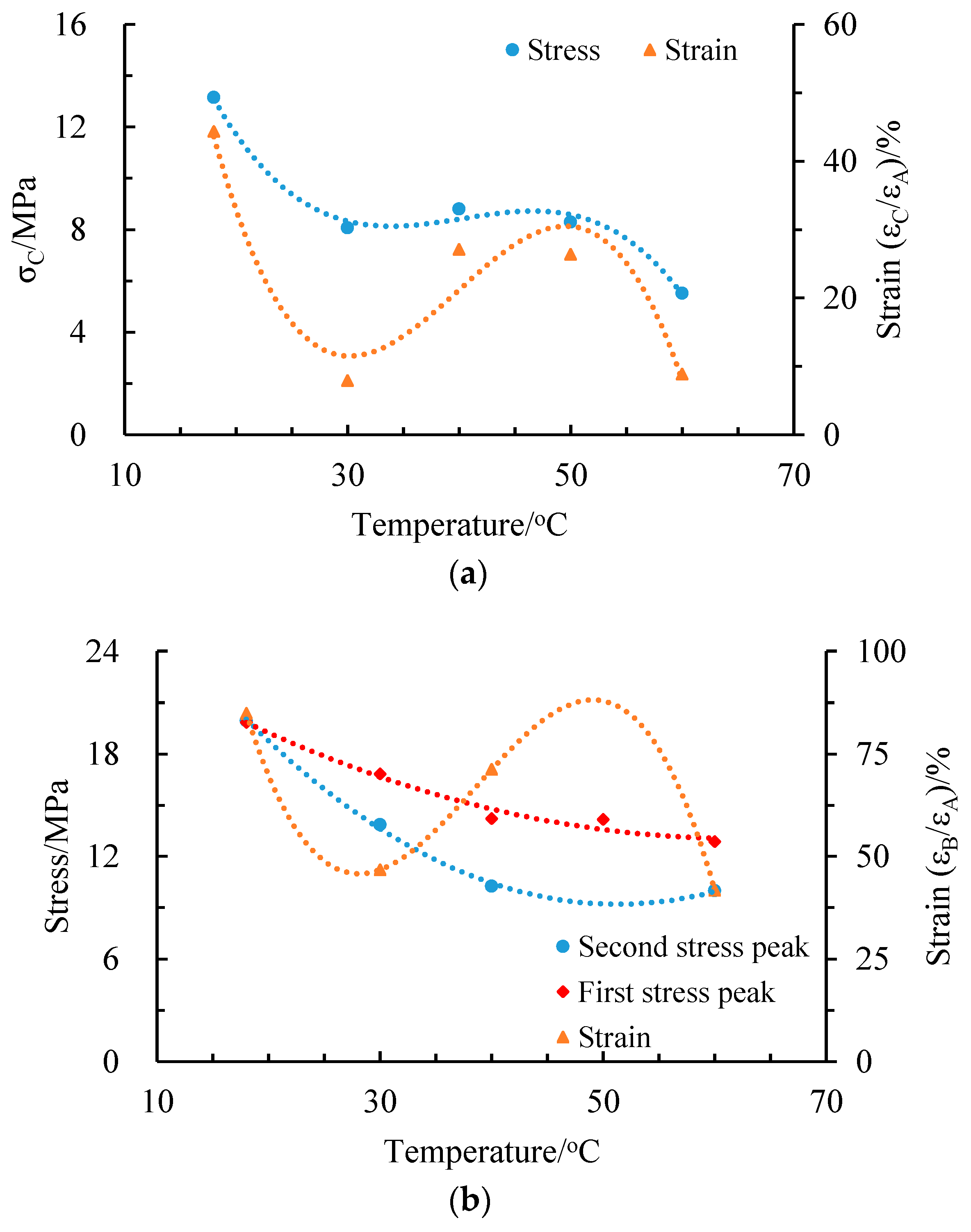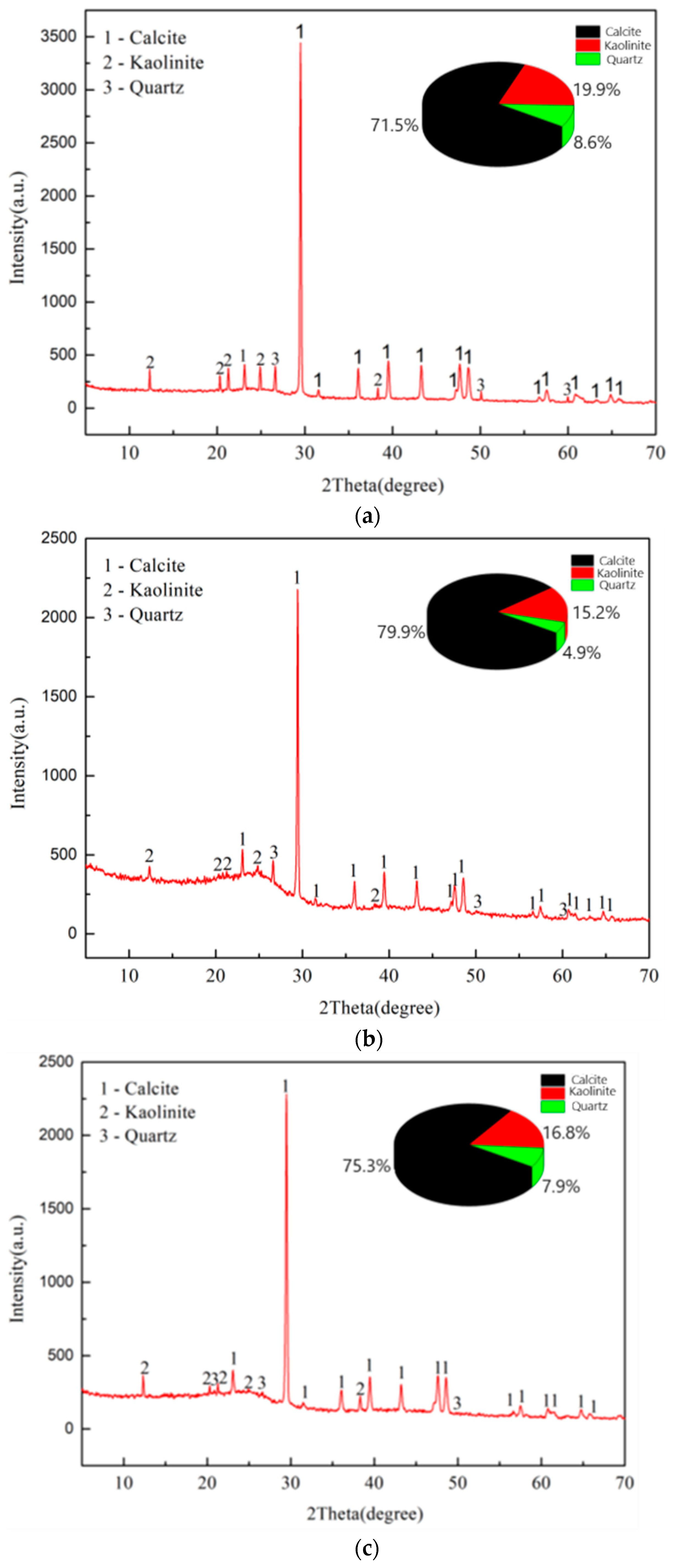Study on Dynamic Parameters and Energy Dissipation Characteristics of Coal Samples under Dynamic Load and Temperature
Abstract
:1. Introduction
2. Experimental System and Method
2.1. System Introduction
2.2. Coal Sample Preparation
2.3. Basic Properties of Coal Samples
3. Experimental Results of Coal Sample Dynamic Load
4. Discussion
4.1. Energy Dissipation
4.2. Energy Dissipation Model
4.3. Development Morphology of Surface Cracks in Coal Samples at Different Temperatures
4.4. Physical Composition of Coal Samples
5. Conclusions
- When the coal body at different temperatures is under dynamic load, the stress curve characterizes the phenomenon of multiple stress peaks. The reason may be that during the impact process, the stress wave partially transmits in the coal body, and the remaining stress wave is superimposed with the reflected wave. Coupled with the heterogeneity of the coal sample and the preheating stress, the internal crack is caused by the extremely fast closure or expansion.
- Under nearly identical bullet incident velocities, the elastomeric stage of the coal sample decreases while the plastic deformation stage increases with rising temperature. Additionally, both the first peak stress and the second peak stress decrease to varying extents.
- When the coal test specimen is under a dynamic load, the abnormal changes in incident energy, reflected energy, and dissipated energy are at 60 °C, and the thermal damage causes the disorder of the internal pores and crack propagation of the coal, which weakens the ability of the coal to resist external loads.
- The macroscopic cracks on the surface of coal samples during impact are characterized by horizontal development, which is consistent with the direction of stress wave propagation. The reasons for crack propagation are analyzed from the aspects of coal physical composition and external joints.
Author Contributions
Funding
Data Availability Statement
Conflicts of Interest
References
- Beeche, C.A.; Garcia, M.A.; Leng, S.; Roghanchi, P.; Pu, J. Computational risk modeling of underground coal mines based on NIOSH employment demographics. Saf. Sci. 2023, 164, 106170. [Google Scholar] [CrossRef]
- Pan, J.; Mao, D.; Lan, H.; Wang, S.; Qi, Q. Study status and prospects of mine pressure bumping control technology in China. Coal Sci. Technol. 2013, 41, 21–25. [Google Scholar]
- Qi, Q.; Chen, S.; Wang, H. Study on the relations among coal bump, rockburst and mining tremor with numerical simulation. Chin. J. Rock Mech. Eng. 2003, 22, 1852–1858. [Google Scholar]
- Jiang, Y.; Pan, Y.; Jiang, F.; Dou, L. State of the art review on mechanism and prevention of coal bumps in China. J. China Coal Soc. 2014, 39, 205–213. [Google Scholar]
- Frew, D.J.; Forrestal, M.J.; Chen, W. Pulse Shaping Techniques for Testing Brittle Materials with a Split Hopkinson Pressure Bar. Exp. Mech. 2002, 42, 93–106. [Google Scholar] [CrossRef]
- Shan, R.-L.; Cheng, R.-Q.; Xu, H.-L.; Yu, H.H. Experimental study on dynamic constitutive characteristics of anthracite of yunjialing coal mine. Chin. J. Rock Mech. Eng. 2005, 24 (Suppl. S1), 4658–4662. [Google Scholar]
- Gao, W.; Shan, R.; Su, Y. Theoretical research on dynamic strength of anthracite under uniaxial impact. Explos. Shock. Waves 2013, 33, 297–302. [Google Scholar]
- Hui, L.X.; Ru, Z.; Liu, J. Dynamic test study of coal rock under different strain rates. J. China Coal Soc. 2012, 37, 1528–1534. [Google Scholar]
- Liu, S.H.; Li, F.M.; Lan, H.; Pan, J.F.; Du, T.T. Experimental study of failure characteristics and mechanism of coal under coupled static and dynamic load. Chin. J. Rock Mech. Eng. 2013, 32 (Suppl. S2), 3749–3759. [Google Scholar]
- Zhao, Y.; Xiao, H.; Huang, Y. Dynamic split tensile test of Brazilian disc of coal withsplit Hopkinson pressure barloading. J. China Coal Soc. 2014, 39, 286–291. [Google Scholar]
- Zhao, Y.; Gong, S.; Hao, X.; Peng, Y.; Jiang, Y. Effects of loading rate and bedding on the dynamic fracture toughness of coal: Laboratory experiments. Eng. Fract. Mech. 2017, 178, 375–391. [Google Scholar] [CrossRef]
- He, J.; Dou, L.-M.; Cai, W.; Li, Z.-L. Mechanism of dynamic and static combined load inducing rock burst in thin coal seam. J. China Coal Soc. 2014, 39, 2177–2182. [Google Scholar]
- Li, M.; Mao, X.; Cao, L.; Mao, R. Experimental study on mechanical properties of coal under high strain rate. J. Min. Saf. Eng. 2015, 32, 317–324. [Google Scholar]
- Li, C.W.; Wang, J.G.; Xie, B.J.; Sun, Y.F. Numerical simulation of SHPB tests for coal by using HJC model. J. Min. Saf. Eng. 2016, 33, 158–164. [Google Scholar]
- Wang, D.K.; Liu, S.M.; Wei, J.P.; Wang, H.L.; Peng, M. Analysis and strength statistical damage constitutive model of coal under impacting failure. J. China Coal Soc. 2016, 41, 3024–3031. [Google Scholar]
- Wang, D.K.; Liu, S.M.; Wei, J.P.; Yao, B.H.; Peng, M. The failure characteristics of coal under impact load in laboratory. J. Min. Saf. Eng. 2017, 34, 594–600. [Google Scholar]
- Wang, Y.; Yang, R. Study of the dynamic fracture characteristics of coal with a bedding structure based on the NSCB impact test. Eng. Fract. Mech. 2017, 184, 319–338. [Google Scholar] [CrossRef]
- Pan, J.; Liu, S.; Yang, L.; Wang, S.; Zhang, C. Experimental study of dynamic characteristics of coal under static and dynamic loads. J. China Univ. Min. Technol. 2018, 47, 206–212. [Google Scholar]
- Guo, D.; Lv, P.; Zhao, J.; Zhu, T. Deformation and damage characteristics and constitutive model of coal and rock under impact loading. J. China Coal Soc. 2018, 43, 2233–2242. [Google Scholar]
- Zhang, Y.; Wang, K. Study on Dynamic Characteristics and Electromagnetic Signal Variation Characteristics of Coal Under Impact Loading. Saf. Coal Mines 2019, 50, 46–49. [Google Scholar]
- Wang, E.; Kong, X.; He, X.; Feng, J.; Ju, Y.; Li, J. Dynamics analysis and damage constitute equation of triaxial coal mass under impact load. J. China Coal Soc. 2019, 44, 2049–2056. [Google Scholar]
- Wang, H.; Gao, Q.; Zong, Q.; Chu, Y. Research on dynamic mechanical properties of hard coal under impact load. J. Min. Saf. Eng. 2019, 36, 344–350. [Google Scholar]
- Wang, W.; Zhang, S.W.; Liu, K.; Wang, S.; Li, D.Y.; Li, H.M. Experimental study on dynamic strength characteristics of water-saturated coal under true triaxial static-dynamic combination loadings. Chin. J. Rock Mech. Eng. 2019, 38, 2010–2020. [Google Scholar]
- Yang, Z.; Fan, C.; Lan, T.; Li, S.; Wang, G.; Luo, M.; Zhang, H. Dynamic Mechanical and Microstructural Properties of Outburst-Prone Coal Based on Compressive SHPB Tests. Energies 2019, 12, 4236. [Google Scholar] [CrossRef]
- Liang, W.; Xin, H.; Liu, H.; Yue, G.; Yang, J. Study on the characteristics of micropore size structure of stratified coal samples after dynamic loading. J. HeNan Polytech. Univ. 2020, 39, 12–19. [Google Scholar]
- Hao, X.; Du, W.; Zhao, Y.; Sun, Z.; Zhang, Q.; Wang, S.; Qiao, H. Dynamic tensile behaviour and crack propagation of coal under coupled static-dynamic loading. Int. J. Min. Sci. Technol. 2020, 30, 659–668. [Google Scholar] [CrossRef]
- Li, J.; Zhao, J.; Gong, S.Y.; Wang, H.C.; Ju, M.H.; Du, K.; Zhang, Q.B. Mechanical anisotropy of coal under coupled biaxial static and dynamic loads. Int. J. Rock Mech. Min. Sci. 2021, 143, 104807. [Google Scholar] [CrossRef]
- Jiao, Z.H.; Mu, C.M.; Wang, L.; Cui, Z.L.; Yuan, Q.P.; Zou, P.; Wang, J. Tests for dynamic mechanical properties of coal impact compression under passive confining pressure. J. Vib. Shock. 2021, 40, 185–193. [Google Scholar]
- Fang, S.; Huo, Y.; Guo, J.; Bai, Z.; Bao, Q.; Zhu, H. Numerical simulation of failure of coal and rock blocks under different dynamic loads. Saf. Coal Mines 2021, 52, 184–188+193. [Google Scholar]
- Zheng, Y.; Shi, H.; Liu, X.; Zhang, W. Failure characteristics and constitutive model of coal rock at different strain rates. Explos. Shock. Waves 2021, 41, 053103. [Google Scholar]
- Zhao, H.; Liu, Y.; Liu, R.; Li, J. Influence of dynamic disturbance on coal-rock damage under local static load constraints. J. HaRBin Inst. Technol. 2022, 54, 80–89. [Google Scholar]
- Sun, Z.; Wu, Y.; Sun, J.; Chen, J.; Fu, Y.; Shan, S. Length-to-diameter ratio effect of dynamic deformation modulus of coal samples under three-dimensional dynamic and static loading. J. Min. Strat. Control. Eng. 2022, 4, 043021. [Google Scholar]
- Wang, K.; Bai, J.; Feng, G.; Yin, D.; Cui, B.; Shi, X.; Yang, X. Mechanical Properties and Failure Behavior of Mortar-Encased Coal Bodies under Impact Loads: Insights from Experimental Investigation. Lithosphere 2022, 2022, 9211516. [Google Scholar] [CrossRef]
- Yang, K.; Liu, W.J.; Ma, Y.K.; Xu, R.J.; Chi, X.L. Experimental study of impact failure characteristics of coal-rock combination bodies under true triaxial loading and single face unloading. Rock Soil Mech. 2022, 43, 15–27. [Google Scholar]
- Xie, B.; Luan, Z.; Chen, D.; Zhong, S. Dynamic characteristics and constitutive model of coal samples with different length diameter ratio. J. Min. Sci. Technol. 2023, 8, 190–201. [Google Scholar]
- Feng, X.; Ding, Z.; Ju, Y.; Zhang, Q.; Ali, M. “Double peak” of dynamic strengths and acoustic emission responses of coal masses under dynamic loading. Nat. Resour. Res. 2022, 31, 1705–1720. [Google Scholar] [CrossRef]
- Kong, X.; Yang, S.; Wang, E.; Li, S.; Lin, H.; Ji, P. Fracture evolution and gas emission characteristics of raw coal samples subjected to instantaneous disturbance of impact loads. Chin. J. Rock Mech. Eng. 2023, 42, 1384–1394. [Google Scholar]
- Shen, R.; Gu, Z.; Wang, E.; Liu, Z.; Liu, W.; Wang, X. Experimental study on impact dynamics and failure characteristics of coal specimen under true triaxial conditions. J. China Coal Soc. 2023, 48, 2168–2178. [Google Scholar]
- Wang, L.; Zhang, S.; Liu, H.; Chen, L. Mechanical properties and damage characteristics of gas-bearing coal under impact loading. J. Min. Saf. Eng. 2023, 14, 2250. [Google Scholar]
- Zhao, E.; Wang, E.; Zang, Z.; Feng, X.; Shen, R. Dynamic Mechanical Characteristics of Impact Rock under the Combined Action of Different Constant Temperatures and Static and Dyna mic Loads. Shock. Vib. 2021, 2021, 8484391. [Google Scholar]
- Lindholm, U.S.; Yeakley, L.M. High strain-rates testing: Tension and compression. Exp. Mech. 1968, 8, 1–9. [Google Scholar] [CrossRef]
- Bacon, C.; Carlsson, J.; Lataillade, J.L. Evaluation of force and particle velocity at the heated end of a rod subjected to impact loading. J. Phys. IV 1991, 1, 395–402. [Google Scholar] [CrossRef]
- GB/T25217; Methods for Test, Monitoring and Prevention of Rock Burst. Standardization Administration of China: Beijing, China, 2021.
- Klyuev, R.V.; Morgoev, I.D.; Morgoeva, A.D.; Gavrina, O.A.; Martyushev, N.V.; Efremenkov, E.A.; Mengxu, Q. Methods of forecasting electric energy consumption: A literature review. Energies 2022, 15, 8919. [Google Scholar] [CrossRef]
- Xie, H.; Peng, R.; Ju, Y. Analysis of energy dissipation in the process of rock deformation of rock deformation and failure. Chin. J. Rock Mech. Eng. 2004, 23, 3565–3570. [Google Scholar]
- Xie, H.P.; Peng, R.D.; Ju, Y.; Zhou, H.W. Energy analysis of rock failure. Chin. J. Rock Mech. Eng. 2005, 24, 2603–2608. [Google Scholar]
- Lundberg, B. A split Hopkinson bar study of energy absorption in dynamic rock fragmentation. Int. J. Rock Mech. Min. Sci. Geomech. Abstr. 1976, 13, 187–197. [Google Scholar] [CrossRef]
- Le, J.L.; Bažant, Z.P.; Bazant, M.Z. Unified nanomechanics based probabilistic theory of quasibrittle and brittle structures: I. Strength, static crack growth, lifetime and scaling. J. Mech. Phys. Solids 2011, 59, 1291–1321. [Google Scholar] [CrossRef]
- Ding, Z.D.; Li, J. A physically motivated model for fatigue damage of concrete. Int. J. Damage Mech. 2018, 27, 1192–1212. [Google Scholar]
- Guo, C.; Li, J. Stochastic fatigue damage model for concrete based on energy dissipation analysis. Chin. J. Comput. Mech. 2023, 40, 666–671. [Google Scholar]








| SN | Experimental Type | Size (mm) | Density (kg/m3) | Wave Velocity (m/s) | Preset Axial Pressure (MPa) | Temperature (°C) | Compressive Strength (MPa) |
|---|---|---|---|---|---|---|---|
| 1 | Uniaxial compression | 40.07 × 39.95 × 80.10 | 1320 | 1695 | - | 18 | 8.01 |
| 2 | 39.87 × 40.14 × 80.15 | 1304 | 1406 | - | 18 | 9.12 | |
| 3 | 40.02 × 40.19 × 80.28 | 1287 | 1352 | - | 18 | 7.29 | |
| 4 | 40.15 × 40.42 × 80.16 | 1370 | 1434 | - | 18 | 5.88 | |
| 5 | 39.87 × 40.12 × 80.11 | 1281 | 1528 | - | 18 | 6.39 | |
| 6 | Dynamic and static load combination experiment | 39.98 × 39.62 × 80.08 | 1372 | 1586 | 1.5 | 18 | - |
| 7 | 40.12 × 40.52 × 79.90 | 1308 | 1689 | 1.5 | 30 | - | |
| 8 | 40.08 × 40.03 × 79.98 | 1271 | 1329 | 1.5 | 40 | - | |
| 9 | 40.49 × 40.13 × 79.32 | 1424 | 1304 | 1.5 | 50 | - | |
| 10 | 39.64 × 40.28 × 80.18 | 1334 | 1672 | 1.5 | 60 | - |
| SN | σC (MPa) | εC | EC (GPa) | σB (MPa) | εB | Secant Elastic Modulus EB (GPa) | σA (MPa) | εA | Secant Elastic Modulus EA (GPa) |
|---|---|---|---|---|---|---|---|---|---|
| 6 | 13.15 | 0.0047 | 3.08 | 19.94 | 0.0090 | 2.22 | 19.84 | 0.0106 | 1.87 |
| 7 | 8.08 | 0.0011 | 10.45 | 13.86 | 0.0065 | 2.13 | 16.83 | 0.0139 | 1.21 |
| 8 | 8.81 | 0.0016 | 7.17 | 10.25 | 0.0042 | 2.42 | 14.22 | 0.0059 | 2.41 |
| 9 | 8.30 | 0.0024 | 4.50 | - | - | - | 14.16 | 0.0091 | 1.56 |
| 10 | 5.52 | 0.0014 | 4.39 | 9.99 | 0.0066 | 1.51 | 12.86 | 0.0158 | 0.81 |
| Factors | Fitted Equation | Correlation Coefficient | Number of Points | Standard Error |
|---|---|---|---|---|
| σC and Temperature | 5 | 0.2467 | ||
| σB and Temperature | 4 | 0.0014 | ||
| σA and Temperature | 8 | 5 | 0.3558 | |
| εC/εA and Temperature | 5 | 3.6692 | ||
| εB/εA and Temperature | 4 | 0.0462 |
Disclaimer/Publisher’s Note: The statements, opinions and data contained in all publications are solely those of the individual author(s) and contributor(s) and not of MDPI and/or the editor(s). MDPI and/or the editor(s) disclaim responsibility for any injury to people or property resulting from any ideas, methods, instructions or products referred to in the content. |
© 2023 by the authors. Licensee MDPI, Basel, Switzerland. This article is an open access article distributed under the terms and conditions of the Creative Commons Attribution (CC BY) license (https://creativecommons.org/licenses/by/4.0/).
Share and Cite
Zhao, E.; Wang, E.; Chen, H. Study on Dynamic Parameters and Energy Dissipation Characteristics of Coal Samples under Dynamic Load and Temperature. Processes 2023, 11, 3326. https://doi.org/10.3390/pr11123326
Zhao E, Wang E, Chen H. Study on Dynamic Parameters and Energy Dissipation Characteristics of Coal Samples under Dynamic Load and Temperature. Processes. 2023; 11(12):3326. https://doi.org/10.3390/pr11123326
Chicago/Turabian StyleZhao, Enlai, Enyuan Wang, and Haopeng Chen. 2023. "Study on Dynamic Parameters and Energy Dissipation Characteristics of Coal Samples under Dynamic Load and Temperature" Processes 11, no. 12: 3326. https://doi.org/10.3390/pr11123326






